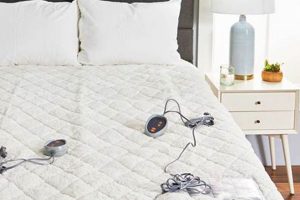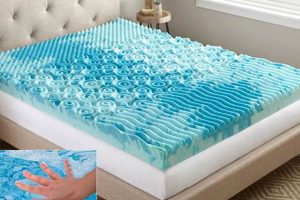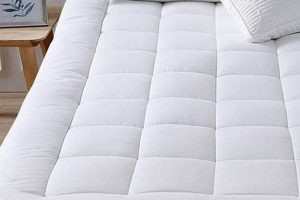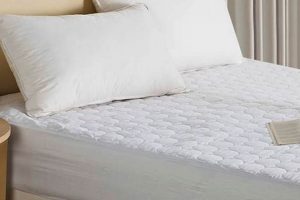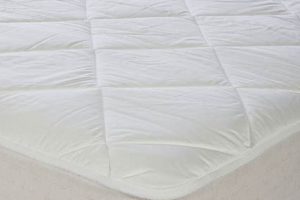The annoyance of bedding components shifting out of place on a sleep surface is a common concern. This displacement often results in discomfort, requiring frequent readjustments and disrupting sleep. For example, a protective layer intended to enhance comfort or prolong the life of a bed can migrate from its intended position, compromising its effectiveness.
Addressing this issue is important because consistent, undisturbed sleep is vital for physical and mental well-being. Historically, various methods have been employed to secure bedding, ranging from simple tethers to more complex fastening systems. The benefits of a stable sleep surface include improved sleep quality, reduced wear and tear on underlying mattresses, and a more aesthetically pleasing bedroom arrangement.
The following sections will explore the primary causes of this instability, examine potential solutions utilizing different materials and design features, and provide practical tips for ensuring a secure and comfortable sleep environment. This encompasses a review of common culprits, such as friction imbalances and improper sizing, followed by a detailed analysis of corrective measures and preventative strategies.
Mitigating Sleep Surface Displacement
The following guidelines provide actionable steps to minimize the unwanted movement of mattress enhancements, ensuring a more stable and comfortable sleep experience.
Tip 1: Employ Fitted Sheets with Deep Pockets: Utilize fitted sheets designed with sufficient depth to securely encompass both the mattress and any additional layers. This added tension helps to anchor the protective layer in place.
Tip 2: Utilize Non-Slip Mattress Grippers: Consider placing a non-slip pad between the mattress and the bed frame. This creates friction, preventing both the mattress and the subsequent layers from shifting.
Tip 3: Select the Correct Size: Ensure the protective layer is appropriately sized for the mattress. An undersized or oversized component is more prone to movement.
Tip 4: Fasten with Mattress Straps or Suspenders: Implement adjustable straps or suspenders designed to secure the protective layer to the mattress. These accessories provide a reliable method for maintaining alignment.
Tip 5: Opt for Materials with Enhanced Friction: Choose protective layers constructed from materials that naturally exhibit higher friction coefficients. This inherent resistance to sliding can significantly reduce movement.
Tip 6: Regularly Inspect and Readjust: Periodically examine the sleep surface for any signs of displacement. Prompt readjustments will prevent minor shifts from escalating into significant issues.
Tip 7: Consider Mattress Pads with Anchoring Bands: Some mattress pads feature elasticized corner bands designed to grip the corners of the mattress. This integrated feature provides a secure and stable fit.
Adhering to these recommendations will contribute to a more stable and restful sleep environment, minimizing disturbances caused by bedding displacement.
The subsequent sections will delve into the long-term implications of consistent displacement and provide further strategies for maintaining optimal sleep surface integrity.
1. Inadequate Friction
Inadequate friction between a mattress and a mattress pad is a primary contributor to the issue of unwanted movement. This lack of resistance allows the pad to shift under pressure, diminishing its intended function and potentially disrupting sleep quality. The relationship between surface texture and frictional force is critical in maintaining stability.
- Surface Texture Compatibility
The textures of both the mattress and the pad surfaces influence friction. Smooth surfaces, such as those found on some memory foam mattresses, offer minimal resistance to movement. When paired with a similarly smooth mattress pad, the absence of interlocking textures facilitates sliding. In contrast, rougher textures, like those found on some quilted mattress surfaces, provide greater friction and inhibit movement. The material composition directly impacts the coefficient of friction between the two surfaces.
- Material Composition and Properties
Certain materials inherently possess lower coefficients of friction. For instance, synthetic materials like polyester or nylon often exhibit smoother surfaces compared to natural fibers like cotton or wool. If a mattress pad is constructed from a slick synthetic material and rests on a similarly smooth mattress, the lack of inherent grip exacerbates the sliding problem. The specific weave or knit of the fabric also influences its frictional properties.
- Presence of Lubricants or Residues
The presence of lubricants, either from manufacturing processes or from body oils and lotions, can reduce friction between the mattress and the pad. Residues accumulate over time, creating a slippery layer that facilitates movement. Even seemingly clean surfaces can harbor microscopic amounts of these substances, contributing to the problem. Regular cleaning of both the mattress and the pad can help mitigate this effect.
- Age and Wear of Materials
As materials age, their surface properties can change, often leading to reduced friction. Repeated use and washing can degrade the fibers of both the mattress and the pad, making them smoother and less able to grip each other. Worn surfaces are more susceptible to sliding than newer, more textured surfaces. Replacing aging bedding components may be necessary to restore adequate friction.
In summary, inadequate friction is a multifaceted issue stemming from surface texture compatibility, material composition, the presence of lubricants, and material degradation. Addressing these factors through careful selection of materials, regular cleaning, and timely replacement of worn components can significantly mitigate the problem of a mattress pad migrating from its intended position, thus enhancing sleep comfort and overall mattress protection.
2. Incorrect Size
The dimensions of a mattress pad relative to the mattress are critical in maintaining stability and preventing unwanted movement. An improperly sized pad introduces instability, compromising its function and contributing to sleep disturbances. Deviations from the correct dimensions, whether too large or too small, impact the pad’s ability to remain securely positioned.
- Oversized Mattress Pad
A mattress pad that exceeds the dimensions of the mattress presents several challenges. Excess material creates slack, which can bunch up or fold over, leading to uneven support and discomfort. The excess fabric is more susceptible to being caught or pulled, increasing the likelihood of displacement during normal movement. The
pad loses its intended shape, diminishing its ability to evenly distribute weight and provide consistent cushioning. Securing an oversized pad becomes problematic, as standard fitted sheets may not adequately contain the excess material, thus failing to hold the pad in place. - Undersized Mattress Pad
A pad that is too small for the mattress fails to provide complete coverage and protection. Gaps appear around the edges, exposing the mattress to potential stains and wear. The elastic or straps designed to secure the pad are stretched beyond their intended capacity, reducing their effectiveness and increasing the risk of detachment. Uneven weight distribution results, as the smaller pad concentrates pressure on a limited area of the mattress. This localized pressure can accelerate wear and tear and compromise the overall comfort of the sleep surface.
- Incompatible Corner Design
Even with generally correct dimensions, a mismatch in corner design can lead to instability. Mattress pads with rounded corners may not fit snugly on mattresses with sharp, square corners, and vice versa. This incompatibility creates gaps and allows the pad to shift, particularly when subjected to pressure. The elasticized edges, if present, may not engage properly with the mattress corners, further diminishing the pad’s ability to stay in place.
- Incorrect Depth Accommodation
Mattresses vary in thickness, and mattress pads must be designed to accommodate this variance. A pad with insufficient depth to cover the mattress sides will not be securely anchored. The elasticized skirt, if present, will ride up the sides, exposing the mattress and increasing the likelihood of the pad becoming dislodged. Conversely, an overly deep pad can create excess material that bunches up, leading to discomfort and instability. Choosing a pad with a depth appropriate for the specific mattress is crucial for maintaining a secure and stable fit.
The issue of improper sizing directly correlates with the stability of the sleep surface. Both oversized and undersized pads, as well as those with incompatible corner designs or depth accommodations, contribute to the problem of displacement. Ensuring an accurate match between the dimensions of the mattress and the pad is fundamental for maintaining a stable and comfortable sleep environment. The stability of the pad is compromised, and therefore the effectiveness of the product’s purpose.
3. Sheet Tightness
Sheet tightness plays a significant, albeit indirect, role in the propensity of a mattress pad to migrate from its intended position. While the sheets themselves are not directly responsible for securing the pad, the tension exerted by improperly fitted or poorly secured sheets can contribute to displacement.
- Inadequate Sheet Fit
Sheets that are too large or lack sufficient elastic tension exert uneven forces on the mattress pad. This uneven pressure can cause the pad to bunch up in certain areas while pulling away from others, disrupting its intended position. The excess fabric creates slack, allowing the pad to shift more easily with movement during sleep. A poorly fitted sheet, therefore, exacerbates the underlying causes of pad displacement, such as inadequate friction.
- Overly Tight Sheets
Conversely, sheets that are excessively tight can also contribute to the problem. Extreme tension can lift the edges of the mattress pad, particularly if the pad is already prone to sliding due to insufficient friction or incorrect sizing. The compressive force exerted by the taut sheet can overcome the pad’s anchoring mechanisms, such as elastic bands or corner straps, effectively pulling the pad out of alignment. An excessively tight sheet acts as a lever, applying force at specific points and disrupting the overall stability of the sleep surface.
- Material Interaction
The material composition of the sheets can interact with the mattress pad in ways that either promote or inhibit slippage. Smooth, slippery sheet fabrics, such as satin or some synthetic blends, offer minimal resistance to movement and can facilitate pad displacement, especially when combined with a similarly smooth pad surface. Conversely, more textured sheet fabrics, like cotton or linen, provide greater friction and may help to anchor the pad, provided they are properly fitted.
- Sheet Fastening Systems
The method used to secure the sheets to the mattress also influences pad stability. Sheets with deep pockets and robust elastic hems provide a more secure fit, minimizing the potential for the sheet to pull on the mattress pad. Conversely, sheets that rely on simple elastic bands or lack sufficient pocket depth are more prone to slipping off the mattress, which can tug on the pad and dislodge it from its intended position. The fastening system’s effectiveness directly impacts the overall stability of the sleep surface.
In conclusion, sheet tightness is a critical factor influencing the stability of a mattress pad. Whether too loose, too tight, or constructed from a material that promotes slippage, improperly fitted or poorly secured sheets can exacerbate the problem of pad displacement. Selecting sheets with an appropriate fit, compatible materials, and a robust fastening system is essential for maintaining a stable and comfortable sleep environment and maximizing the benefits of the mattress pad.
4. Anchor Failure
Anchor failure, in the context of mattress pads, refers to the compromised integrity or functionality of the mechanisms designed to secure the pad to the mattress. This failure is a direct causal factor in the problem of a mattress pad continually shifting from its intended position. The anchoring system, typically consisting of elastic corner straps, fitted skirts, or integrated fastening mechanisms, is essential for maintaining the pad’s placement. When these components fail, the pad loses its secure connection to the mattress, leading to displacement. The absence of a reliable anchoring system renders the pad vulnerable to movement caused by normal sleep activity. For instance, a common scenario involves elastic corner straps losing elasticity over time, rendering them incapable of maintaining tension and allowing the pad to slide off the mattress corners. The practical significance of understanding anchor failure lies in recognizing the need for durable and properly functioning attachment systems to ensure consistent pad placement and the intended comfort and protective benefits.
Further analysis reveals that anchor failure can manifest in several forms, each with distinct contributing factors. Material degradation, such as the fraying or tearing of fabric skirts, compromises their ability to grip the mattress sides. Seam detachment, where the anchoring components separate from the main body of the pad, eliminates the connection entirely. Design flaws, such as poorly positioned or inadequately sized straps, may fail to provide sufficient holding force from the outset. Furthermore, improper installation or use can accelerate anchor failure. For example, stretching elastic straps beyond their elastic limit during installation can weaken them prematurely. The selection of mattress pads with robust, well-designed, and properly maintained anchoring systems is crucial for preventing displacement. An additional example is where the sewn edge with the el
astic band becomes detached.
In summary, anchor failure is a primary driver of mattress pad displacement, stemming from material degradation, design flaws, and improper use. Addressing this issue requires selecting pads with durable anchoring systems, ensuring correct installation, and performing regular inspections for signs of wear or damage. A thorough understanding of the mechanisms of anchor failure is therefore essential for maintaining the stability and functionality of mattress pads, ultimately contributing to improved sleep quality and mattress protection. The challenge lies in creating anchoring systems that can withstand repeated use and laundering while maintaining their integrity over the lifespan of the pad.
5. Surface Material
The composition of the surface materials, both of the mattress and the mattress pad itself, significantly influences the friction coefficient between the two surfaces. This characteristic directly impacts the propensity of the pad to shift during use.
- Coefficient of Friction
The coefficient of friction is a measure of the resistance to relative motion between two surfaces in contact. Materials with low coefficients of friction, such as smooth synthetic fabrics, offer minimal resistance, facilitating easy movement. In contrast, materials with high coefficients of friction, like textured cotton or natural rubber, provide greater resistance and inhibit sliding. The specific values are determined empirically and vary based on the materials involved. For instance, a polyester mattress pad on a slick polyurethane mattress will exhibit a significantly lower coefficient of friction compared to a cotton pad on a wool mattress. In cases where the friction is too low, the mattress pad may shift.
- Material Texture and Weave
The texture and weave pattern of the surface material contribute to its frictional properties. Rough or porous surfaces, like those found in some woven cotton fabrics, offer more points of contact and increased mechanical interlocking, resulting in higher friction. Smooth or tightly woven surfaces, such as those in satin or microfiber, provide fewer contact points and reduced interlocking, leading to lower friction. For example, a quilted mattress pad with a textured surface is more likely to remain in place than a smooth, non-quilted pad made of similar materials. The weave affects its ability to grip.
- Surface Treatments and Coatings
Various surface treatments and coatings can alter the frictional properties of mattress pad materials. For instance, waterproofing treatments, while providing protection against spills, often reduce surface friction, making the pad more prone to sliding. Similarly, silicone-based coatings, used to enhance softness, can also decrease friction. These treatments modify the surface characteristics, impacting the interaction with the mattress surface. The application affects how easily it slides.
- Age and Degradation
The surface properties of materials can change over time due to wear, washing, and exposure to body oils and fluids. Repeated use can smooth out textured surfaces, reducing their frictional properties. The accumulation of residues, such as body oils or detergent, can also create a lubricating layer that facilitates sliding. Regular cleaning and maintenance can help preserve the surface integrity and frictional properties of the materials. Regular use degrades surface integrity over time.
In summary, the surface material composition, including its coefficient of friction, texture, weave pattern, surface treatments, and degradation over time, plays a critical role in determining the stability of a mattress pad. Selecting materials with inherently higher friction coefficients, avoiding slippery surface treatments, and maintaining the cleanliness of both the pad and the mattress can significantly reduce the likelihood of unwanted movement, enhancing sleep comfort and preserving the intended benefits of the pad.
6. Weight Distribution
Uneven weight distribution across a sleep surface is a significant contributing factor to mattress pad displacement. When body weight is not uniformly supported, concentrated pressure zones develop, creating localized forces that can cause the pad to shift from its intended position. This phenomenon is particularly pronounced in cases where the pad already suffers from issues such as inadequate friction or improper sizing. For example, individuals who primarily sleep on their side often exert greater pressure on the hip and shoulder areas, leading to a localized depression in the mattress and a corresponding shift in the pad. The importance of uniform weight distribution as a component of mattress pad stability is evident in its ability to maintain consistent contact between the pad and the mattress, preventing areas of slack or excessive pressure that facilitate movement. An uneven distribution essentially creates leverage points that encourage the pad to slide or bunch. An individual with a significantly higher Body Mass Index would also contribute to significant localized stress.
Analyzing the practical applications, a person sharing a bed with a partner may find that differences in body weight or preferred sleeping positions result in disparate pressure points. These pressure differentials can induce the pad to migrate towards the side bearing less weight, especially if the anchoring system is not robust enough to withstand the forces. The materials and design of the mattress itself play a role, as mattresses with varying degrees of support can exacerbate or mitigate the effects of uneven weight distribution. Mattresses with poor motion isolation may also transfer movement and weight shifts more readily, further contributing to pad displacement. The understanding that weight impacts this is crucial to addressing the core issues of the pads slipping.
In summary, uneven weight distribution is a key driver of mattress pad instability. Concentrated pressure zones induce localized forces that overcome frictional resistance and compromise anchoring systems. Addressing this issue requires considering individual sleeping habits, differences in body weight between partners, and the support characteristics of the underlying mattress. Mitigating the effects of uneven weight distribution contributes to a more stable and comfortable sleep environment, ensuring that the mattress pad remains in its intended position and continues to provide its intended benefits. One potential challenge is in accounting for the natural shifting that occurs during sleep, emphasizing the need for durable anchoring solutions and materials that can withstand dynamic pressure changes. The problem goes beyond the surface of the product.
Frequently Asked Questions
The following section addresses common inquiries related to the issue of mattress pads shifting from their intended position, providing clear and informative answers.
Question 1: What are the primary causes of a mattress pad repeatedly sliding off a mattress?
The persistent displacement of a mattress pad can typically be attributed to a combination of factors including insufficient friction between the pad and the mattress, incorrect sizing of the pad relative to the mattress, and compromised anchoring mechanisms such as worn elastic straps or loose-fitting skirts. Material composition of both the mattress and the pad also
plays a crucial role, with smoother surfaces exhibiting less resistance to sliding.
Question 2: How does the type of mattress affect whether a mattress pad stays in place?
The surface characteristics of the mattress significantly influence pad stability. Mattresses with smooth, non-textured surfaces, such as those made of certain memory foam formulations, offer less friction than mattresses with quilted or textured surfaces. This lack of friction increases the likelihood of pad displacement. The contouring of a mattress will affect the pad slipping if it doesn’t accommodate the shape.
Question 3: What role does sheet tightness play in preventing a mattress pad from sliding?
Sheet tightness can exert both positive and negative influences on pad stability. Appropriately fitted sheets with sufficient elastic tension can help to secure the pad, while overly loose sheets offer inadequate restraint and contribute to movement. Conversely, excessively tight sheets can lift the edges of the pad, predisposing it to displacement. The sheet and pad need to be considered a cohesive unit.
Question 4: Are there specific mattress pad materials that are more resistant to sliding?
Mattress pads constructed from materials with higher coefficients of friction, such as natural latex or densely woven cotton, tend to exhibit greater resistance to sliding. These materials offer enhanced grip compared to smoother synthetic fabrics like polyester or microfiber. The gripping power will reduce how often it slides.
Question 5: How frequently should a mattress pad be adjusted to prevent it from becoming significantly displaced?
The frequency of readjustment depends on the severity of the underlying issues contributing to the sliding. However, a periodic inspection, approximately every one to two weeks, is recommended to identify and correct any minor shifts before they escalate into more significant displacement problems. A regular check will stop it from becoming unmanageable.
Question 6: Can the weight distribution of the sleeper contribute to mattress pad displacement?
Uneven weight distribution can indeed exacerbate the problem. Concentrated pressure zones created by specific sleeping positions or differences in body weight can induce localized shifts in the pad, particularly if the anchoring system is weak or the frictional resistance is low. An uneven distribution will make this problem worse.
Addressing the issue of mattress pad displacement involves a comprehensive approach that considers material selection, sizing accuracy, sheet fit, anchoring system integrity, and sleeping habits.
The subsequent section will provide a detailed overview of preventative measures and long-term strategies for maintaining mattress pad stability.
Mitigating Mattress Pad Displacement
The persistent issue of “mattress pad keeps sliding” stems from a complex interplay of factors, as this analysis has demonstrated. The root causes encompass inadequate friction, incorrect sizing, improper sheet tightness, anchor failure, unsuitable surface materials, and uneven weight distribution. Addressing this widespread concern necessitates a multi-faceted approach, emphasizing careful product selection, diligent maintenance, and a thorough understanding of the contributing elements.
Sustained attention to these variables will yield significant improvements in sleep quality and mattress protection. Therefore, a proactive posture, characterized by routine inspection and preemptive adjustment, remains essential. By recognizing and rectifying the underlying causes, individuals can achieve a more stable sleep surface, ensuring both comfort and the long-term preservation of their bedding investments. The stability of this product enhances the lifespan of your investments.



